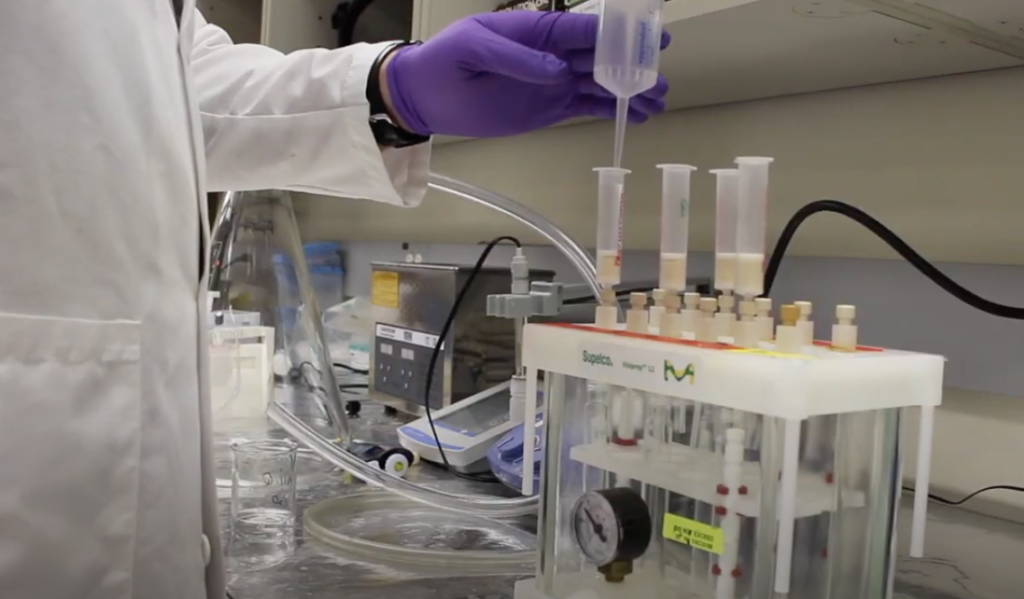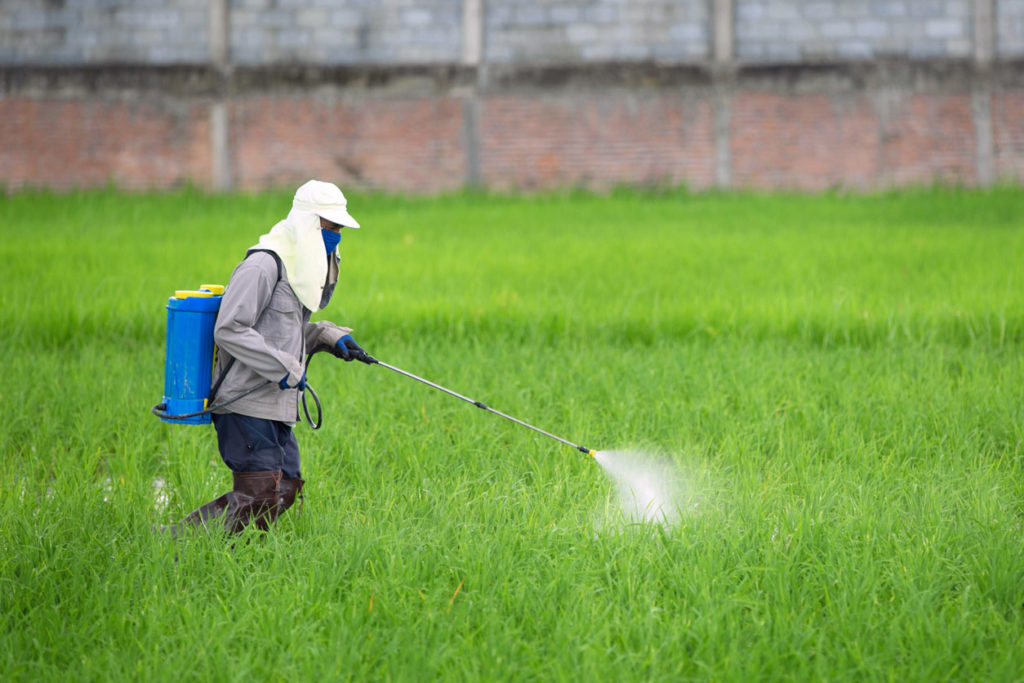Phd Candidate Derek Simonsen explains the work that goes on in Dr. Hans Lehmler’s lab and the Exposure Science Facility. Watch it now!

Environmental Health Sciences Research Center
University of Iowa College of Public Health
Phd Candidate Derek Simonsen explains the work that goes on in Dr. Hans Lehmler’s lab and the Exposure Science Facility. Watch it now!

The College of Public Health’s Distinguished Faculty Lecture will take place on December 2, 2020, from 12:30-1:30 P.M. This year’s lecture will be given by EHSRC member, Dr. Fred Gerr, and will provide an overview of historical and current occupational injury and illnesses among meat packing plant workers.
Dr. Gerr has served as a professor in the Department of Occupational and Environmental Health for the last 18 years. He has been the director of both the Great Plains Center for Agricultural Health and the Occupational Medicine Residency Training Program in CPH for many years. He has taught Occupational Health Practice, Occupational Medicine, and Interpreting Occupational Health Research. His research focuses on occupational and environmental risk factors for neurological impairment and musculoskeletal disorders. He has made significant contributions in the specialty of occupational and environmental medicine.
2020 CPH Distinguished Faculty Lecture | December 2 at 12:30 P.M.
Join via Zoom (https://uiowa.zoom.us/j/93121351181)

Dr. Brandi Janssen, Director of the EHSRC Community Engagement Core, collaborated with colleagues at Emory, University of North Carolina, and University of New Mexico to publish a paper about reporting back to communities. It was featured as a paper of the month on the NIEHS Environmental Factor newsletter. See write up below:
NIEHS grantees developed a framework and set of recommendations to help environmental health researchers return research results to study participants, a process called result report-back. According to the authors, report-back has the potential to improve environmental health education and communication and overall public health. Despite strong recommendations for report-back, researchers share results with study participants infrequently and inconsistently, the authors said.
To create the framework, the researchers used feedback from 35 community engagement practitioners who participated in a workshop at the 2018 NIEHS Partnerships for Environmental Public Health Annual Meeting. Workshop attendees responded to the prompt: “What are some specific issues that are relevant to reporting back research results to individuals or the larger community?” Participants then grouped similar responses and rated groups by importance to successful result report-back. The researchers used qualitative and quantitative methods to create a framework, called a concept map, to visualize relationships between responses.
Five themes emerged from this process. Listed from most to least important, the themes were: effective communication strategies, community knowledge and concerns, uncertainty, empowering action, and institutional review and oversight. Engaging community partners in the process of result report-back emerged as a unifying global theme. The researchers further examined responses and made recommendations to address challenges within and across themes.
Environmental health researchers and practitioners should address these five specific themes when planning and implementing their result report-back activities, say the authors.
Citation: Lebow-Skelley E, Yelton S, Janssen B, Erdei E, Pearson MA. 2020. Identifying issues and priorities in reporting back environmental health data. Int J Environ Res Public Health 17(18):6742.
The Human Toxicology and EHSRC Research Seminar line-up has been announced. Seminars are every Friday at 10:45 am and will be via zoom. Check out the page for more details
Researchers for the Pulmonary Toxicology Facility and the Exposure Science Facility contributed to a paper in Infection Control & Hospital Epidemiology entitled, “Inactivation of SARS-CoV-2 and Diverse RNA and DNA Viruses on 3D Printed Surgical Mask Materials”.
View the paper here:
Unsafe application of pesticides is a major health risk among young agricultural workers in low- and middle-income countries. To help address that problem, NIEHS grant recipient Diane Rohlman, Ph.D., and collaborators in Egypt developed an intervention that improved the workplace behaviors and hygiene practices of adolescent field laborers in that country. Rohlman is a professor of occupational and environmental health at the University of Iowa.
Young people are more susceptible to negative health effects of pesticides than adults, and more likely to engage in unsafe work habits, increasing their risk of exposure, according to the study. The authors noted that adolescents who spray the chemicals on crops can exhibit poor lung function and neurobehavioral problems, including attention-deficit hyperactivity disorder.
Through funding from NIEHS and the National Institutes of Health Fogarty International Center, the researchers fostered several positive changes among the teens, including the following:

“In order for people to change their behavior, they have to believe that they are at risk,” said Rohlman. “They also have to know what to do to protect themselves and believe that these behaviors will protect them.”
After conducting field observations and surveys, the team placed approximately 120 participants into risk categories. Those who viewed pesticides as a major health threat and felt they could take precautions were called responsive. Adolescents who did not view pesticides as a serious risk and did not think they could improve safety were called indifferent.
Next, the researchers provided a one-hour training session on reducing pesticide exposure and enhancing hygiene. They found that after the intervention, about 90% of participants fell into the responsive group, whereas before the intervention, only about 42% were in that category.
The scientists followed up with the adolescents after eight months. Positive behavioral changes were sustained during that period, although the percentage of responsive participants dropped slightly. Rohlman said that with regular intervention, her approach can provide a low-cost way to reduce harmful exposures in a variety of agricultural and industrial settings.
“NIEHS partners with Fogarty to support collaborative research on brain and nervous system disorders,” said Kimberly Gray, Ph.D., health scientist administrator in the institute’s Population Health Branch. “Rohlman’s project contributes to the long-term goal of building sustainable research capacity in low- and middle-income countries.”
Rohlman met her Egyptian collaborators at a scientific conference in the United States. “It has been a wonderful experience working with colleagues from Menoufia University,” she said.
The researchers worked closely with the Ministry of Agriculture in Egypt, where cotton production is highly regulated. The ministry, which hires adolescents to work in fields during the summer, was actively involved in on-site training and focus group discussions with participants.
Noting that she and the research team would like to continue this initiative, Rohlman said that she hopes her intervention can be used in other countries.
Many children and teenagers work as pesticide applicators. However, most research into the chemicals focuses on unborn and newborn babies, according to Rohlman. To help fill that gap, she studies how the substances affect the adolescent brain.
High-exposure participants show neurobehavioral deficits that last months after the pesticide application season ends, noted Rohlman, who added that more research is needed.
Citation: Rohlman DS, Davis JW, Ismail A, Abdel Rasoul GM, Hendy O, Olson JR, Bonner MR. 2020. Risk perception and behavior in Egyptian adolescent pesticide applicators: an intervention study. BMC Public Health 20(1):679.
(Arif Rahman, Ph.D., is a visiting fellow in the National Toxicology Program Toxicoinformatics Group.)
This year the Iowa Governors Conference on Public Health has been moved online. A benefit of this is that presentations are available for anyone to watch! The Community Engagement Core’s Jackie Curnick presented about “Scientific Communication Approaches to Improve Environmental Health Literacy” on April 15, 2020. Watch the presentation here! (presentation starts around 7 minutes 30 seconds)
The EHSRC has awarded the most recent round of Pilot Grants. There are four awarded projects. Congrats to the investigators! See the list here
The goals of the pilot program are to:
EHSRC investigators wear many hats, both inside and outside of their membership with the Center. Many have been active contributors in response to the emerging questions and needs during the COVID-19 pandemic. As experts in the fields of respiratory health, industrial hygiene, engineering, aerosol science, patient care, vaccine development, and community engagement, they are tirelessly offering up their expertise to the cause by developing new technologies and interventions, working the front lines of patient care, delving into the complex infrastructural challenges, and advising governmental authorities and the general public. We are proud to count them among our members and pay tribute to their ongoing efforts in this fight.
The EHSRC will still be hosting weekly seminars on Fridays via zoom. Check out our seminar page to see the most up to date info!
Article by Tom Snee, University of Iowa published here
A new study from the University of Iowa suggests that people who have higher levels of a chemical in their body that indicates exposure to commonly used insecticides die of cardiovascular disease at a significantly higher rate.
Findings from the study, published in the journal JAMA Internal Medicine, suggest those who have high levels of exposure to pyrethroid insecticides are three times more likely to die of cardiovascular disease than people with low or no exposure.
Wei Bao, assistant professor of epidemiology in the University of Iowa College of Public Health and the study’s corresponding author, says the findings come from an analysis of a nationally representative sample of American adults, not just those who work in agriculture. That means the findings have public health relevance to the general population.
He also cautions that as an observational study, the research does not determine if the people in the sample died as a direct result of their exposure to pyrethroids. He says that the results indicate a high likelihood of a link, but more research is needed to replicate the findings and determine the biological mechanisms.
Pyrethroids are among the list of commonly used insecticides with the largest market share and they constitute the majority of commercial household insecticides. They are found in numerous commercial insecticide brands and are used widely in agricultural, public, and residential settings for pest control. Metabolites of pyrethroids, such as 3-phenoxybenzoic acid, can be measured in the urine of people who are exposed to pyrethroids.
Bao and his team of researchers analyzed data on 3-phenoxybenzoic acid levels in urine samples collected from 2,116 adults aged 20 and over who participated in the United States National Health and Nutrition Examination Survey between 1999 and 2002. They cross-referenced mortality records to determine how many of those adults in their data sample had died by 2015 and of what cause.
They found that during an average 14 years of observation, those people who had the highest levels of 3-phenoxybenzoic acid in their urine samples were 56% more likely to have died of any cause by 2015 than people with the lowest levels of exposure. Cardiovascular disease was by far the leading cause of death, with a three times greater likelihood.
While Bao’s study did not determine how the subjects became exposed to pyrethroids, he says previous studies show that most exposure to pyrethroids is through food, as people who eat fruits and vegetables that have been sprayed with them ingest the chemical. Residential use of pyrethroids in gardens and homes for pest-control is also a significant source of exposure. Pyrethroids are also present in household dust in homes that apply these pesticides.
Bao notes that the market share of pyrethroid insecticides has increased since the 1999–2002 study period, which makes it likely the rate of cardiovascular disease-related deaths related to its exposure has increased, as well. However, Bao says, further investigation is needed to assess whether this hypothesis holds.
The paper, “Association Between Exposure to Pyrethroid Insecticides and Risk of All-Cause and Cause-Specific Mortality in the General US Adult Population,” was co-authored by Buyun Liu and Hans-Joachim Lehmler in the UI College of Public Health and Derek Simonsen, a UI graduate student in human toxicology. It was published in the Dec. 30, 2019, issue of JAMA Internal Medicine.